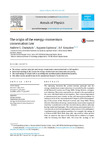
Please use this identifier to cite or link to this item:
http://ricaxcan.uaz.edu.mx/jspui/handle/20.500.11845/534Full metadata record
| DC Field | Value | Language |
|---|---|---|
| dc.contributor.other | https://orcid.org/0000-0001-5324-1834 | es_ES |
| dc.contributor.other | https://orcid.org/0000-0002-1478-7946 | es_ES |
| dc.coverage.spatial | Global | es_ES |
| dc.creator | Chubykalo, Andrew | - |
| dc.creator | Espinoza, Augusto | - |
| dc.creator | Kosyakov, Boris Pavlovich | - |
| dc.date.accessioned | 2018-06-12T16:28:58Z | - |
| dc.date.available | 2018-06-12T16:28:58Z | - |
| dc.date.issued | 2017-07 | - |
| dc.identifier | info:eu-repo/semantics/publishedVersion | es_ES |
| dc.identifier.issn | 0003-4916 | es_ES |
| dc.identifier.uri | http://hdl.handle.net/20.500.11845/534 | - |
| dc.identifier.uri | https://doi.org/10.48779/xm0a-1k79 | - |
| dc.description.abstract | The interplay between the action–reaction principle and the energy–momentum conservation law is revealed by the examples of the Maxwell–Lorentz and Yang–Mills–Wong theories, and general relativity. These two statements are shown to be equivalent in the sense that both hold or fail together. Their mutual agreement is demonstrated most clearly in the self-interaction problem by taking account of the rearrangement of degrees of freedom appearing in the action of the Maxwell–Lorentz and Yang–Mills–Wong theories. The failure of energy–momentum conservation in general relativity is attributed to the fact that this theory allows solutions having nontrivial topologies. The total energy and momentum of a system with nontrivial topological content prove to be ambiguous, coordinatization-dependent quantities. For example, the energy of a Schwarzschild black hole may take any positive value greater than, or equal to, the mass of the body whose collapse is responsible for forming this black hole. We draw the analogy to the paradoxial Banach–Tarski theorem; the measure becomes a poorly defined concept if initial three-dimensional bounded sets are rearranged in topologically nontrivial ways through the action of free non-Abelian isometry groups. | es_ES |
| dc.language.iso | eng | es_ES |
| dc.publisher | Elsevier | es_ES |
| dc.relation | https://www.sciencedirect.com/science/article/pii/S0003491617301847 | es_ES |
| dc.relation.uri | generalPublic | es_ES |
| dc.rights | Atribución-NoComercial-CompartirIgual 3.0 Estados Unidos de América | * |
| dc.rights.uri | http://creativecommons.org/licenses/by-nc-sa/3.0/us/ | * |
| dc.source | Annals of Physics, Vo. 384, Septiembre 2017. | es_ES |
| dc.subject.classification | CIENCIAS FISICO MATEMATICAS Y CIENCIAS DE LA TIERRA [1] | es_ES |
| dc.subject.other | Action–reaction | es_ES |
| dc.subject.other | Translation invariance | es_ES |
| dc.subject.other | Energy and momentum conservation | es_ES |
| dc.subject.other | Rearrangement of initial degrees of freedom | es_ES |
| dc.title | The origin of the energy–momentum conservation law | es_ES |
| dc.type | info:eu-repo/semantics/article | es_ES |
| Appears in Collections: | *Documentos Académicos*-- UA Física | |
Files in This Item:
| File | Description | Size | Format | |
|---|---|---|---|---|
| 2017_Annals_of_Physics.pdf | 532,18 kB | Adobe PDF |  View/Open |
This item is licensed under a Creative Commons License
